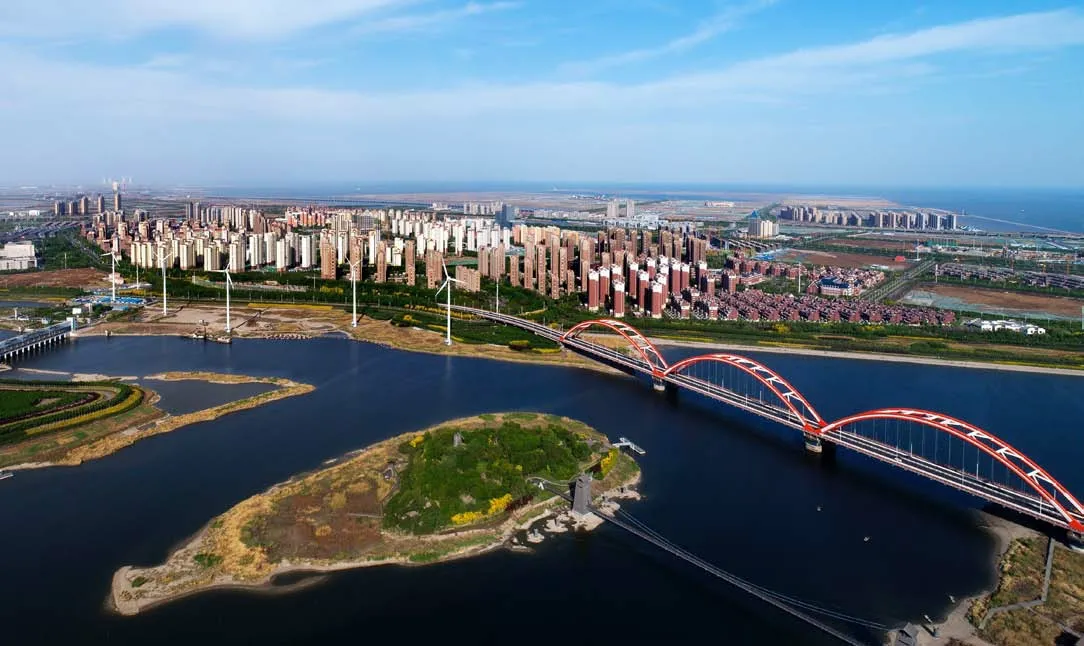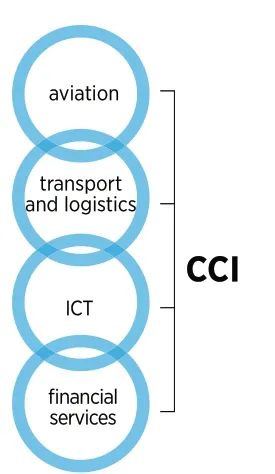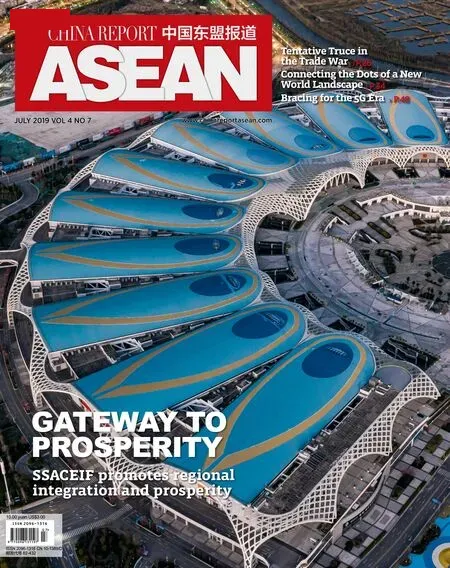SINGAPORE'S ENGAGEMENT WITH BRI
By Chong Jing Yee

A panorama of China-Singapore Tianjin Eco-City, the second Sino-Singaporean government-to-government cooperation project.
THE SINGAPOREAN GOVERNMENT IS ACTIVELY BOLSTERING ECONOMIC COOPERATION WITH CHINA
“T he Belt and Road Initiative[BRI] can contribute greatly to a peaceful, orderly shift in the global order and support China's constructive international role commensurate with its size and potential,” uttered by Singapore's Prime Minister Lee Hsien Loong during a five-day visit to Beijing for the second Belt and Road Forum—an international summit led and hosted by Chinese President Xi Jinping. Noting that Singapore had been an “early and strong supporter”of the BRI, Lee asserted that Singapore was well placed to make a “modest contribution” to the BRI. He cited the example of the Chongqing Connectivity Initiative (CCI)—a joint Sino-Singapore project launched in 2015—as an area where Singapore could make a useful contribution to the BRI through improving land and sea trade and transport connectivity.
Indeed, since China and Singapore established diplomatic relations on October 3, 1990, the two countries have remained excellent partners in the pursuit of mutually beneficial economic cooperation. The China-Singapore Free Trade Agreement(CSFTA), for instance, was first signed in 2009, marking the first time an Asian country signed a comprehensive Free Trade Agreement with China.Likewise, in November 2004, China and the 10 member states of the Association of Southeast Asian Nations(ASEAN) signed an agreement to set up the China-ASEAN Free Trade Area(CAFTA). Originally involving three segments of the economy including goods, services and foreign direct investment (FDI), the CAFTA's upgrade in 2018 included dimensions of increased China-ASEAN engagement premised upon the BRI such as connectivity, trade, investment and cultural exchange. Against the backdrop of the U.S.-China trade war and other Trumpian policies aiming to isolate China from its international peers,bilateral and regional platforms for economic cooperation are—and will remain—vital to China and Singapore's future.
Promoting Economic Relations with China
Traditionally, Singapore has always been welcoming to foreign investment and trade.Its attitude towards the BRI is no exception. Singapore's efforts to develop and promote a more sustainable diplomatic cooperation model with China have played out on two main fronts: First, the banking and financial sector, including established giants such as homegrown United Overseas Bank, which collaborates with China-based banks to deliver more resource-efficient crossborder financial services for the funding of BRI projects and the pursuit of regional connectivity initiatives. As illustrated by a report by recruitment consultant Hays Singapore, the attention of Singapore's banks has been increasingly focused on the ASEAN and China markets,culminating in their financing of BRI projects—offering project and export finance, loans, trade and cash management solutions as well as financial market products.

On December 14,2018, a container semi-trailer serving the ASEAN Regular Lorry arrives in Singapore after a seven-day drive from Chongqing, China.
Additionally, banks have also stepped up efforts to provide cross-border financing services. On September 5,2018, Singapore's UOB signed a Memorandum of Understanding(MOU) with China's Shanghai Pudong Development Bank (SPD)with the intention of serving companies seeking to tap on opportunities arising from the BRI. At the same time, alongside cooperation projects which cover investment advisory and cross-border renminbi (RMB)transactions, UOB and SPD have also pursued strengthening inter-bank businesses such as granting loans and managing deposits while providing a platform for start-up companies to access financial technology ecosystems necessary for funding and sponsorship.Consequently, in the words of UOB Head of Group Wholesale Banking Frederek Chin, such collaborations “will strengthen our efforts to help companies tap the increasing regional crossborder flows arising from the BRI and other regional connectivity initiatives.”
Second, Singapore's government has also been actively assisting in and promoting cooperation with China within the framework of the BRI. Recognizing the potential of China's rise to international prominence,Singapore's government launched Business China in 2007 with the intention of nurturing inclusive bilingual and bicultural Singaporeans capable of ensuring Singapore remains relevant in its diplomatic engagements with China. In the words of Singaporean PM Lee, “China's next phase of development will be different from the past... We must find new solutions as our own circumstances change so we can continue to improve Singaporean lives and remain relevant to other countries,including China.”

The CCI aims to accelerate the growth of China's western regions across four fronts:aviation, transport and logistics,information and communications technology (ICT)and financial services.

Singapore has solidified its position at the top of the list of foreign investors in China,pumping US$5.8 billion into over 700 projects in 2014 alone.
Against this backdrop,Business China has conducted a wide variety of activities that appeal to different segments of Singaporean society. For businesses, for instance,Business China organizes the annual FutureChina Global Forum, which is designed to provide a platform to share analysis and trends related to the forces shaping China's growth and development. Gathering experts, corporate leaders and academics specializing in relevant fields, the forum seeks to help participants develop a holistic understanding of China's societal and economic growth and implications on the region—and specifically,Singapore. Similarly, Business China also actively engages with Chinese firms to create opportunities for Singaporean enterprises to leverage crossborder collaboration. At 2017's FutureChina Global Forum, for example, Business China signed an MOU with 10 Singaporean and Chinese enterprises to formalize and promote crossborder collaboration.
For students, Business China has created programs designed to help students develop a comprehensive and clear understanding of China.Under the Business China Youth Chapter, members are granted opportunities to immerse themselves in Chinabased internships and learning journeys to learn about Chinese business culture.
Likewise, Singapore's government announced numerous initiatives targeting stimulating economic cooperation between the governments of Singapore and China. CCI is one such example.Launched in 2015, the CCI aims to accelerate the growth of China's western regions across four fronts: aviation, transport and logistics, information and communications technology(ICT) and financial services. The goal of the CCI is to facilitate linkage of Southeast Asia to China. By doing so, Singapore's government hopes China-Singapore bilateral economic relations will be strengthened through pursuit of shared benefits and common goals.In the words of Singapore's Minister for Trade and Industry Chan Chun Sing, “The CCI is not a zero-sum game. The more people that use this network to move goods, the lower the price will be. The more people come to participate in this network, the more economic benefits we [Singapore and China] have.” It is clear that Singapore's government has enthusiastically embraced the boundless potential of China-Singapore economic cooperation and the benefits,tangible and otherwise, it brings to both sides.
New Opportunity for China-Singapore Cooperation
The BRI involves economic cooperation between China and a wide spectrum of states, so why is China-Singapore economic cooperation so worthy of study?First, at the most fundamental level, China and Singapore are very much dependent on each other for economic prosperity.Since 2014, China has entrenched its position as Singapore's largest trading partner. During this same time period, Singapore has solidified its position at the top of the list of foreign investors in China, pumping US$5.8 billion into over 700 projects in 2014 alone. Looking back at China-Singapore trade and investment trends over the past years, we can safely conclude that they are vital to the creation of fresh economic development opportunities and growth.
In the face of the trade war,China-Singapore economic cooperation provides a convenient platform through which China can benefit from trade and investment diversion.As George Yeo asserted in the Singaporean newspaper TODAY,China has increasingly sought to relocate its lower value-added manufacturing activities to other countries to bypass costadding tariffs and trade barriers imposed by the U.S. on Chinese exports.
Especially in recent years, the U.S. has clearly sought to curb China's rising prominence in the international realm—based on fear that China will pose a threat to the U.S.-centric world order on military, ideological and economic fronts. Yet,as existing China-Singapore economic collaboration has shown, China's promotion of the BRI has served to welcome,rather than ostracize, China into the international community.Through building mutual trust by China acting as a benefactor,China-Singapore cooperation within the BRI signals potential for developing East Asian regionalization that cannot be disentwined from rising China.
At the end of the day,Singapore's public and private sectors have both played an active and effective economic role in their engagement with China within the framework of the BRI. Bilateral economic cooperation is emblematic of the willingness and commitment of both sides to maintain favorable diplomatic ties built on trust rather than suspicion and cooperation instead of competition.
Since China and Singapore established diplomatic relations on October 3, 1990,the two countries have remained excellent partners in the pursuit of mutually beneficial economic cooperation.

